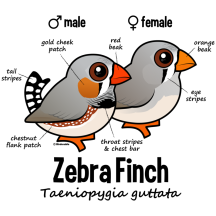Introducing the Birdorable Zebra Finch

Zebra Finches are common finches that live all over Australia. They have also been introduced and live wild in Portugal and the United States. Males are beautifully marked with bright orange beaks and orange cheeks. Zebra Finches are known for their enthusiastic and creative singing and are... Read more »








































